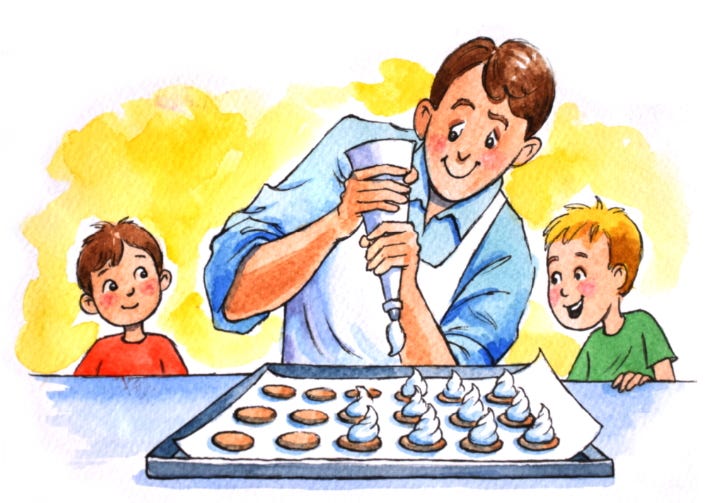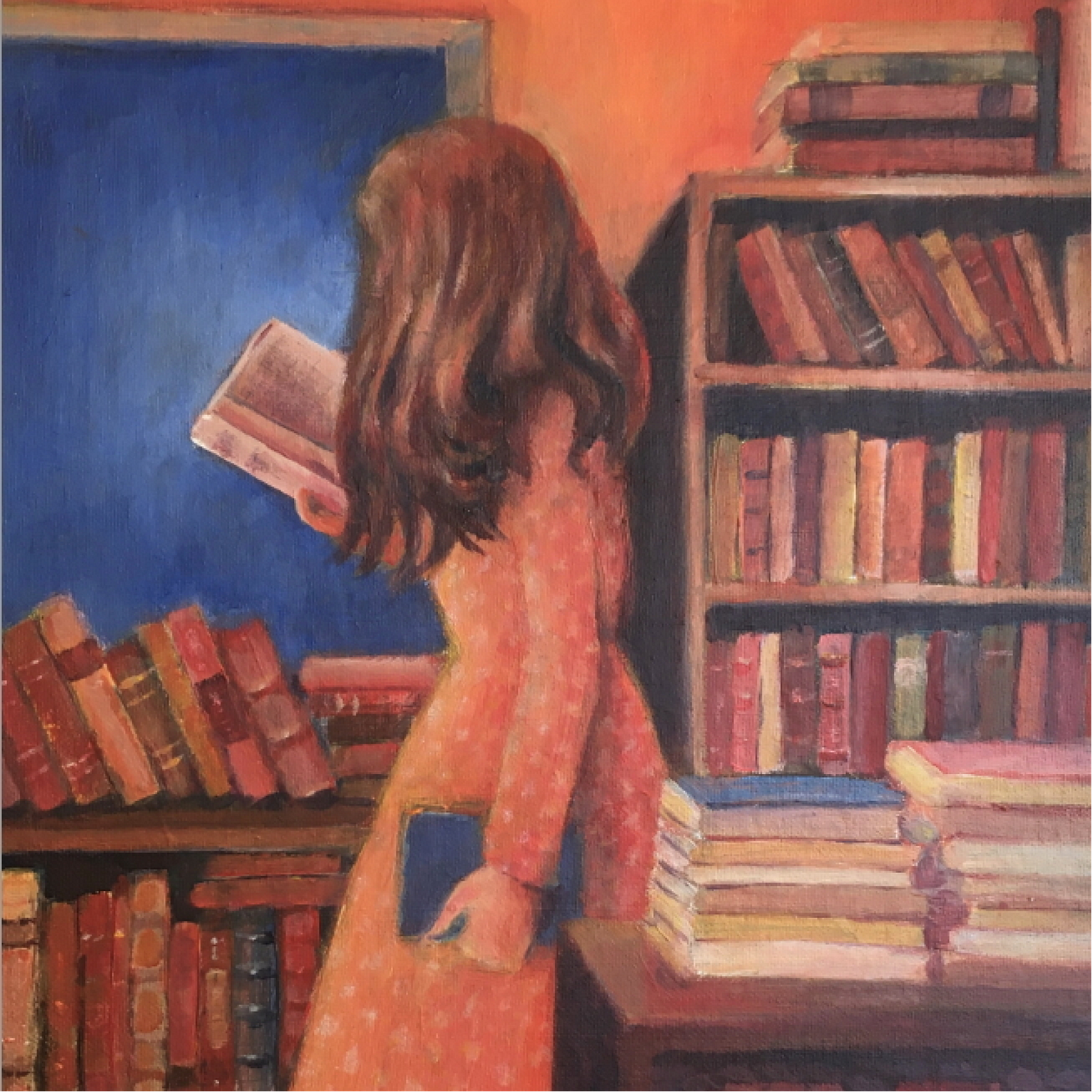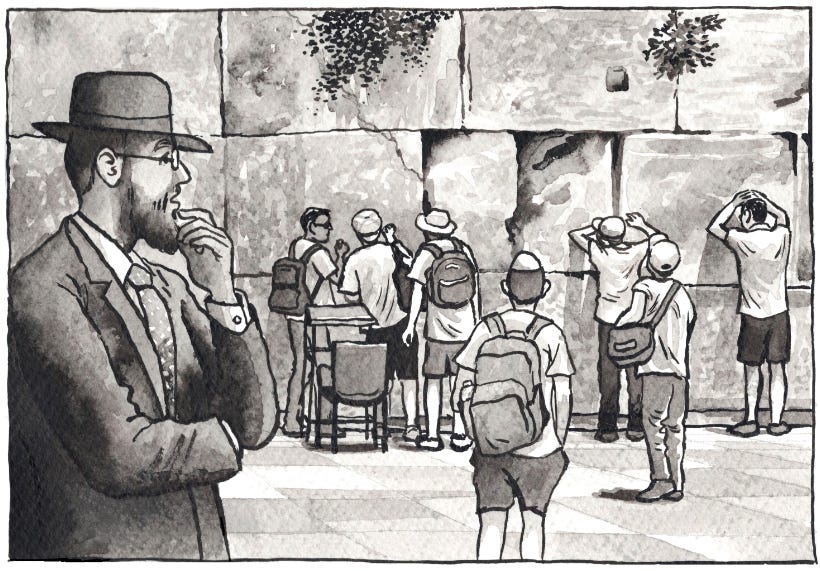Dena Ackerman - a chat about illustration, storytelling, and the misconception of medium
The words are only half the story. This conversation veers into new territory and finally sheds light on the visuals. Dena Ackerman’s illustrations are easy to pick out. They’re fresh, fun, and different due to her traditional and handmade style of pencils, watercolors, and more. Dena grew up in Los Angeles, California, and now lives in Beit Shemesh, Israel. Aside from personal commissions, she illustrates children’s books and book covers and is working on her own children’s book.
Lots of people draw as a hobby. What led you to do this professionally?
I've been drawing all my life. I started when I was little and never stopped. I sold work and took commissions, but it wasn't a profession. People knew that I painted and would ask me now and then. About ten years ago, a friend recommended me to someone looking for an illustrator for a children's book. I took that job, and that was when I realized I could do it professionally.
I categorize what I do into two categories, fine art (usually portraiture) and illustration. Fine art is something you would hang on your wall, a landscape, portrait art, or some kind of Judaica. An illustration is created to accompany something. It usually accompanies a text, book, advertisement, poem, or something like that.
Are there any books or illustrations you enjoyed in your childhood that continue to impress you?
So many, if I would have to make a list, we could talk about it all night. Some children’s books that stand out are “Peter Pan,” illustrated by Trina Schart Hyman, “The Velveteen Rabbit,” and the Half Magic books, whose line drawings by N. M. Bodecker are equally magical. I also love the line drawings in The Borrowers books, The Little House on the Prairie series, and lots of illustrated fairy tales with pictures by Henry J. Ford.
I loved reading too. Those were my two things; I was either reading or drawing. So the fact that they often went together was a bonus. I think both reading and drawing are ways of expressing things. People talk about painting with words, or you could paint with actual paints. But art is also often a form of storytelling as well. So you're not necessarily just trying to create something pretty; you're trying to say something, convey an emotion or experience.
Could you describe what the process is like for a typical illustration project?
There are lots of different types of illustrations, not every process is exactly the same; some things take a lot longer than others. They'll tell me what they want, whether it’s a magazine illustration, an ad, or even greeting cards. I'll do a sketch or two, send it to them and get their feedback on it. And they'll say, great, go ahead. Or they'll say, can we tweak it this way or that way? Once we've cleared the sketch stage, I'll go ahead and create the artwork. It’s a simple process.
When it’s a children's book, I’ll first read the book, and then there's an extra stage, the thumbnails. They're very small, quick, very messy sketches. You basically want to lay out each page with the text and illustrations so that you can just see how the book will flow. I'm not trying to show very much with the illustrations, I just want to show that this page is going to be a close-up of someone's face, or a full scene, a playground with a lot of kids... Illustrating a children’s book typically takes three to six months, but it can take much longer if the illustrations are more complex.


I might be working with the author, the publisher, or if someone's self-publishing, I work directly with them. There was a time when I was working with authors who had a book accepted by a publisher, but the publisher told them to find and pay their own illustrator. I really didn’t like that because the authors don’t make enough from their books to make it worth it to pay my prices. So I prefer to work for the publisher, they pay me, and then they pay the author their royalties.
When I’m working with the publisher, they decide if they want to involve the author or not. In the secular world, when an author submits a manuscript to a publisher, they usually won’t have any say in the illustrations and may not see it until the book's finished. They're selling their manuscript over to the publisher to do what they think will be best for it. The frum world is a little more Heimish. If the author really wants to be involved, the publisher will sometimes accommodate them.
Does the publisher come to you with a specific vision, or do they leave that up to you?
They usually leave it up to me. At this point, I have a pretty extensive portfolio where a client could look up what I do. And if they think what I've already done is a good match and my style will work for their book, and if I like the story, then I'll do it. I'm not taking jobs right now where they want a style that's not mine, that I don't identify with.
I still have a variety of styles. So there's still discussion about what exactly the final one will look like. Once in a while, I do go through a few different samples before we decide.
Something that stands out about your work is the diverse styles and mediums you use. Where do you get the inspiration to keep trying new things? Isn't it easier to stick to one?
I'm always trying new things. I get inspired very easily, and then I want to try things out. I use Pinterest to collect things, sometimes a photograph I see, or sometimes someone else's artwork that I want to try to incorporate some elements of into my own work. I also listen to a lot of podcasts while I'm working. There's this one podcast that I just found recently that keeps mentioning all these artists and illustrators I've never heard of. So every time they mention a name, I have to pause it and look it up and see if it's somebody that I want to look at more of their work. I try to keep learning and absorbing things. You could just learn for the next thousand years and not read everything or see everything.
A lot of frum art looks very similar; there's a lot of emphasis in the frum world on creating realistic-looking art, these doll-like faces. I don't know why. I'm just guessing, but I feel like a lot of frum artists don't have a lot of exposure to other types of art in general because maybe they're not going to museums or public libraries, and they're only seeing the art that's already in the frum world. So they're just kind of copying what's already there.
Are there any mediums that are more or less appropriate for kids?

I don't think so. I think it's a misconception that kids need a specific style. I was once doing black and white illustrations for a series, and the author was upset that they weren't colored; she thought kids just reacted better to color. But I don't think they do at all. I remember lots and lots of books from when I was a kid that were in black and white that I loved.
I have one publisher concerned about things I would never have thought of. Like one of my ideas was a kid flicking something into their mouth and swallowing it. They thought that wasn't good because it's a choking hazard and we shouldn't encourage the kids to do that. Personally, I don't think kids need to be protected and cuddled. I think they're okay with a certain level of scary images, which I never get to do. We have this book called Hershel and the Hanukkah Goblins. The illustrations are very scary, and my kids are fascinated by them. They have all these goblins and monsters, it’s in the middle of the night in this old deserted shul on top of a mountain. I think frum kids could use more of that.
How does a book’s genre or message affect the planning of the illustrations?
So it’s usually not an issue. There was one time the genre was really different, one of my favorite projects. I illustrated a book of five Rebbi Nachman stories for the Breslov Institute, all kind of fairy tale-ish with kings, princes, paupers, and journeys. They wanted each of the five stories to be illustrated in a different style and also at a different time. So we have one that's these medieval woodcuts, another where everyone's wearing Renaissance gowns, another is Edward Gorey style. They were all black and white, but the style didn't necessarily tie into the stories.
I illustrated a book for Brocha Getz called Hashem’s Candy Store, it’s about eating healthy food. Since it’s not a story, nothing's really happening. It's just talking about how carrots look like eyes and are good for your eyes, and walnuts are good for your brain. So I actually created a story. You see these kids going to the fruit and vegetable shop, then driving somewhere, then you see all the family members joining, and then they're having a picnic. So there's a progression. Each page matches the text, so if they're talking about fruits and watermelon, that's the page that has everyone eating watermelon. I tried to create a story that's going on through the book, even though it wasn't one.

You've mentioned in interviews before that you're working on your own kid's book. How’s that going?
I really want to do my own book because I feel like it's a complete vision. It's something you see a lot in the secular world and not so much in the frum world.
The book I’m working on now is a book of poems about the seasons. It's not necessarily for frum kids. I want it to be universal, but something that Jewish families would have in their houses. I'm also unsure how much I can get away with if I want frum families to buy it. Can I put little kids in bathing suits for the summer? Can I even put kids without kipas? I don't know.
I’ve been working on it for years. Now and then I get an urge to work on it, and then something else comes up, and it gets pushed aside. I'm also much more of a perfectionist when it comes to producing my own work. If it's somebody else's book, I can churn out sketches, get their okay, and then churn out the illustrations. It has to be good, I have to be happy with it, but I'm not like agonizing over every little thing. So I feel like I need to relax a little bit with my own children's book. I think the problem is it’s my first book, so I treat it as my one and only, like this has got to be my masterpiece. It's really silly because I should just get it done, and then I could do another one. None of them have to stand on their own.
How would you break down talent, skill, and experience in illustration?
I think talent plays a role in giving you the passion to continue and work at it. Most people who don’t feel like they have talent don't even try. But I know of people who never drew at all as a kid and later discovered they had a talent or a passion for it.
The most important thing is practice, just keep drawing, training your eyes and hands, and creating muscle memory for drawing certain things and understanding how colors work. They say you need to create lots of bad art before you can create good art, you've got to get the bad out of your system first. I think I got a lot of my bad art out as a kid. Some of my students who start later are still getting all their bad art out and trying to learn all the basic skills when they're older.

Do you think that there are opportunities for frum women in illustration?
I have some illustration students who are working now and do have work coming in. And I think some of them would like to have more work than they're getting. If you're looking for a quick way to make money, it's not like you could take an illustration course for six months, and you’re suddenly an illustrator getting good-paying jobs. You'll have to start at the bottom, grow your portfolio and experience, and be willing to work at it for a few years until you're good enough to make the kind of money you want.
Obviously, some people will get there quicker than other people. Some people have so much charm in their work, that while their work may not be technically perfect, their coloring might not be great, or their facial expressions are a little off, something about it is just so charming that it works. You don't even have to know all the rules of perspective, anatomy, or color theory. Some people have an instinct for creating art that appeals to people.
With all of these new digital tools, how have you seen the trends or expectations in illustration change?
I work traditionally. I use real paints and pencils and then scan it in so I can give them digital files. I clean it up on the computer, sometimes I use more digital tools than others. But usually, it's mostly just traditional art. I see mostly digital art in the frum books, so I'm always excited when I see something that's hand done. Thankfully people still appreciate it, and I'm still getting offers.
A bunch of frum illustration courses are springing up now, I've heard of two or three recently. There have always been in-person ones. Gadi Pollak teaches, and he has students who teach. So now they're going online. I’m a little concerned that the digital courses are just jumping straight into digital. It’s interesting since the goal of digital art is to look hand done. That’s why there are so many Photoshop brushes supposed to mimic watercolor effects or pencil effects. So good digital artists usually have a background in traditional art. Some of the art is incredible and really beautiful. I don't think one form is necessarily better than the other, but I think it helps an artist to have experience with different mediums before they jump into just working digitally.
What are your favorite frum books?
I really liked Yedidya by Naomi Elbinger, she's a friend of mine. I also have two books I keep returning to. The Way it Was is so touching and beautiful, about growing up Jewish in Philadelphia. I also liked No Greater Treasure, about women from Talmud and Midrash. I can't say it’s novel form, but it's written like short stories as if it's happening.
For kids, I love the Savta Simcha books. I think those should be a Jewish classic; they probably are. I would also recommend David Adler’s two series he wrote for Menucha Publishers, which I’ve illustrated. The first was Me, My Dog, and I, and the other is called Jelly Elly Z, for slightly older kids. Those are really good.
What are you working on now?
I'm working on a biography about Rabbi Mayer Schuster, short, simple chapters with black and white pictures. Biographies are a different type of challenge because I'm using photos and I want it to match the time period. This book is the fourth in the series that I’m doing for Menucha. Each one is a different challenge because of the different periods. I did one of Sara Schenirer, with a different look and a different era. I got to pick the style we would do it in. It involves more research, but it's really fun.





